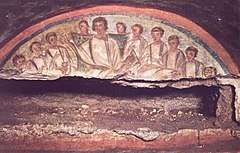Jesus predicts his death

There are several references in the Synoptic Gospels (the gospels of Matthew, Mark and Luke) to Jesus predicting his own death, the first two occasions building up to the final prediction of his crucifixion.[1] Matthew's Gospel adds a prediction, before he and his disciples enter Jerusalem, that he will be crucified there.[2]
In the Gospel of Mark, generally agreed to be the earliest Gospel, written around the year 70,[3][4] Jesus predicts his death three times. Walter Schmithals, noting that this Gospel also contains verses in which Jesus appears to predict his Passion, suggests that these represent the earlier traditions available to the author, and the three death predictions are redactional creations of the author.[5] The setting for the first prediction is somewhere near Caesarea Philippi, immediately after Peter proclaims Jesus as the Messiah. Jesus tells his followers that "the Son of Man must suffer many things and be rejected by the elders, chief priests and teachers of the law, and that he must be killed and after three days rise again".[6] When Peter objects, Jesus tells him: "Get behind me, Satan! You do not have in mind the things of God, but the things of men". (Mark 8:31–33)
The Gospel of Matthew 16:21–28 includes this episode,[7] saying that Jesus "from that time", i.e. on a number of occasions, Jesus "began to show his disciples that he must go to Jerusalem and suffer many things from the elders and chief priests and scribes, and be killed ...".[8]
The Gospel of Luke 9:22–27 shortens the account, dropping the dialogue between Jesus and Peter.
Each time Jesus predicts his arrest and death, the disciples in some way or another manifest their incomprehension, and Jesus uses the occasion to teach them new things.[9] The second warning appears in Mark 9:30–32 (and also in Matthew 17:22–23) as follows:
He said to them, "The Son of Man is going to be betrayed into the hands of men. They will kill him, and after three days he will rise." But they did not understand what he meant and were afraid to ask him about it.[10]
The third prediction in the Matthew 20:17–19 specifically mentions crucifixion:
Now as Jesus was going up to Jerusalem, he took the twelve disciples aside and said to them, "We are going up to Jerusalem, and the Son of Man will be betrayed to the chief priests and the teachers of the law. They will condemn him to death and will turn him over to the Gentiles to be mocked and flogged and crucified. On the third day he will be raised to life!"[11]
The fourth prediction in Matthew is found in Matthew 26:1-2 immediately precedes the plot made against him by the religious Jewish leaders:
"As you know, the Passover is two days away—and the Son of Man will be handed over to be crucified."
The hypothetical Q source, widely considered by scholars to be a collection of sayings of Jesus used, in addition to the Gospel of Mark, by the authors of the Luke and Matthew Gospels, contains no predictions of the death of Jesus.[12]
The Gospel of John, in chapters 12 to 17, also mentions several occasions where Jesus prepared his disciples for his departure, which the gospel also refers to as his "glorification":[13]
Jesus answered them, saying, “The hour has come that the Son of Man should be glorified. Most assuredly, I say to you, unless a grain of wheat falls into the ground and dies, it remains alone; but if it dies, it produces much grain.[14]
See also
Notes
- ↑ St Mark's Gospel and the Christian faith by Michael Keene 2002 ISBN 0-7487-6775-4 pages 24-25
- ↑ The Temptations of Jesus in Mark's Gospel by Susan R. Garrett 1996 ISBN 978-0-8028-4259-6 pages 74-75
- ↑ Witherington (2001), p. 31: 'from 66 to 70, and probably closer to the latter'
- ↑ Hooker (1991), p. 8: 'the Gospel is usually dated between AD 65 and 75.'
- ↑ Walter Schmithals, The Theology of the First Christians (Westminster John Knox Press, 1997) page 22.
- ↑ The Gospel according to Mark: meaning and message by George Martin 2005 ISBN 0-8294-1970-5 pages 200-202
- ↑ Matthew for Everyone: Chapters 16-28 by Tom Wright 2004 ISBN 0-664-22787-2 page 9
- ↑ Matthew 16:21
- ↑ Mercer Dictionary of the Bible by Watson E. Mills, Roger Aubrey Bullard 1998 ISBN 0-86554-373-9 page 550
- ↑ "Bible Gateway passage: Mark 9:30-32 - New Revised Standard Version".
- ↑ "Bible Gateway passage: Matthew 20:17-19 - New International Version".
- ↑ John S Kloppenborg, Q, the Earliest Gospel (Westminster John Knox Press, 2008) page 75.
- ↑ Dictionary of biblical imagery by Leland Ryken, Jim Wilhoit, Tremper Longman, Colin Duriez, Douglas Penney, Daniel G. Reid 1998 ISBN 0-8308-1451-5 page 269
- ↑ Template:BibleverseJohn12:23-24NKJV
References
- Books
- Barclay, William (2001). The Gospel of John, Volume 1. Westminster John Knox Press. ISBN 9780664237806.
- Davies, Stevan L. (2004). The Gospel of Thomas and Christian Wisdom. Bardic Press. ISBN 9780974566740.
- Fitzmyer, Joseph A. (1985). The Gospel According to Luke, X-XXIV. The Anchor Bible Reference Library. Doubleday. ISBN 9780300139815.
- Harrington, Daniel J. (1991). The Gospel of Matthew. Liturgical Press. ISBN 9780814658031.
- Hooker, Morna (1991). The Gospel According to Saint Mark. Continuum. ISBN 9780826460394.
- Witherington, Ben (2001). The Gospel of Mark: A Socio-Rhetorical Commentary. Eerdmans Publishing. ISBN 9780802845030.